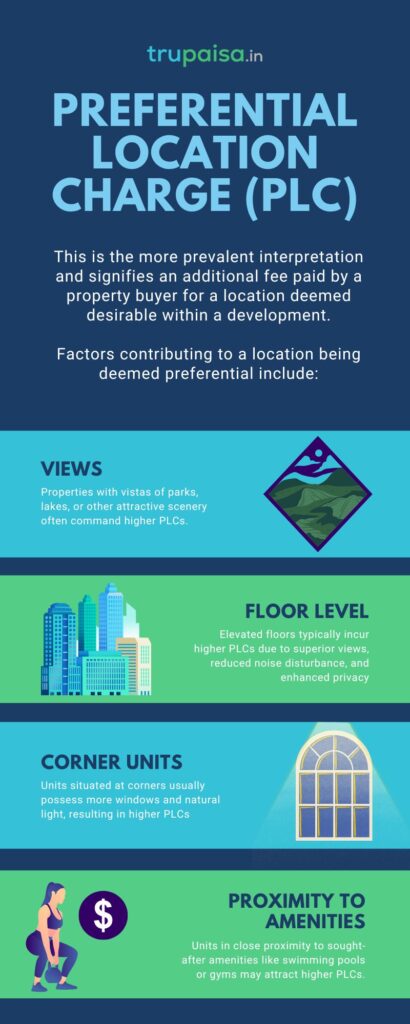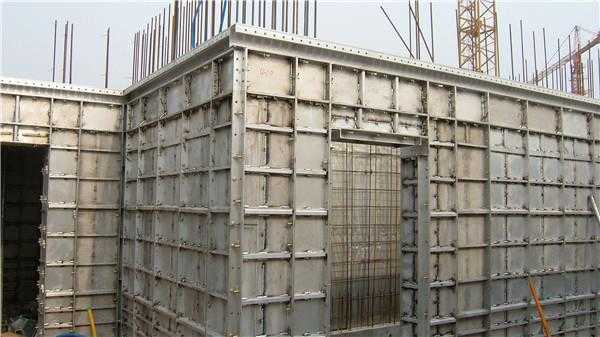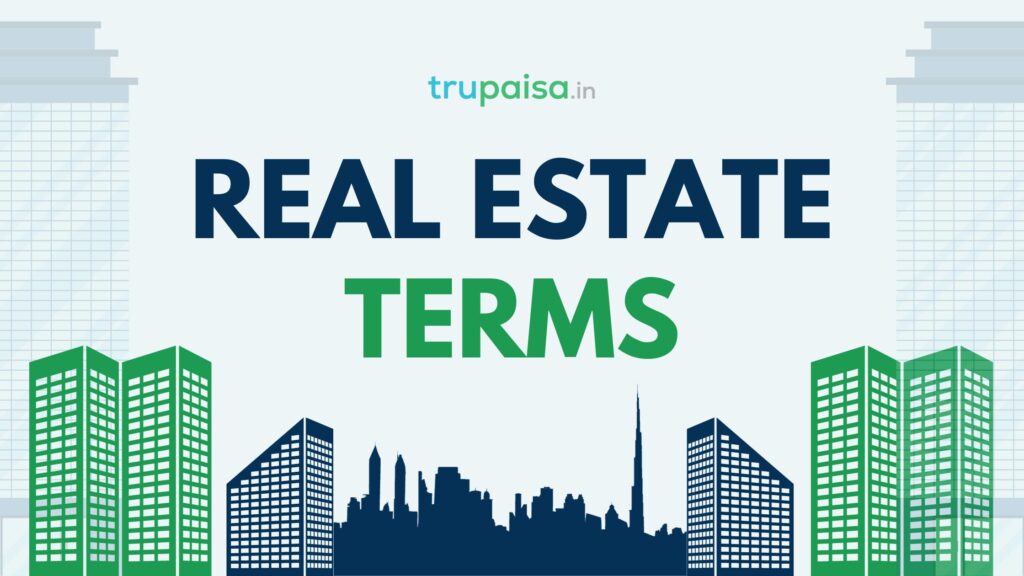PLC Full Form In Real Estate
💡 Preferential Location Charges (PLC) in real estate refer to the additional costs charged for specific advantageous locations within a project. These charges are becoming a standard component of the total cost of a housing unit, with trends in PLC changing to accommodate buyer requirements.
PLC in real estate may denote two distinct concepts:
1. Preferential Location Charge (PLC)

PLC meaning In Real Estate! Above infographic is self explanatory.
However, detailed explanation is given below:
This is the more prevalent interpretation and signifies an additional fee paid by a property buyer for a location deemed desirable within a development. Factors contributing to a location being deemed preferential include:
Views
Properties with vistas of parks, lakes, or other attractive scenery often command higher PLCs.
Floor level
Elevated floors typically incur higher PLCs due to superior views, reduced noise disturbance, and enhanced privacy
Corner units
Units situated at corners usually possess more windows and natural light, resulting in higher PLCs
Proximity to amenities
Units in close proximity to sought-after amenities like swimming pools or gyms may attract higher PLCs.

2. Pre-Lease Construction (PLC)
This less common interpretation involves PLC standing for “Pre-Lease Construction.”
This refers to an agreement between a developer and a tenant wherein the tenant commits to leasing a property before its construction is complete.
In such instances, the tenant might receive a reduced rent or other benefits as compensation for assuming the risk associated with the construction project.
It is crucial to acknowledge that the specific meaning of PLC hinges on the contextual usage. If uncertain, seeking clarification from the person employing the term is advisable.
Additionally, here are some key considerations regarding PLCs:
- The PLC amount is typically subject to negotiation between the buyer and the developer.
- PLCs are not always disclosed upfront, emphasizing the need to thoroughly review the sale agreement before committing.
- * PLCs can substantially augment the total cost of a property, necessitating inclusion in budget considerations.
PS: In north Indian, its hot environment is usually hot and because of this top floors are not preferred. Means, lowers floor are in more demand. That prompted a realtor (builder) to make flats on lower floor a prime/ property.
Besides this, you may be keen to know about FRC in real estate.
So, what is FRC in real estate?
FRC stands for Floor Rise Charges. Some highlights about it is as under:
- An additional fee for higher floors in a multi-story building.
- Rationale: Higher floors offer better views, less noise, and potentially higher resale value.
- The amount is usually determined by the developer based on a pre-defined formula.
- Typically transparently communicated upfront as part of the overall pricing.
In summary, PLC considers the location’s desirability within a project, while FRC is solely for the floor level.
PLC can vary based on specific features, while FRC follows a predetermined formula.
Both add to the final property cost, so understanding their differences is crucial when making purchase decisions.
PS: I am sure by now PLC meaning in real estate would have been clear.
What is Real Estate? Some of my friend may not know what does it mean. Real Estate is a term used for any property in the form of land, villa, apartment or a commercial building.
www.trupaisa.in
How Is PLC Calculated?
The calculation of Preferential Location Charges (PLC) in real estate varies depending on several factors, including:
- Project type: Luxury projects generally have higher PLCs compared to budget-friendly developments.
- City location: Prime locations within major cities command higher PLCs than suburban areas.
- Climatic conditions: Properties with desirable views or access to amenities like pools or parks might have higher PLCs.
- Floor level: Higher floors usually come with better views and privacy, leading to higher PLCs.
- Developer’s policy: Each developer has its own approach to calculating PLCs, incorporating market trends and internal pricing strategies.
However, the basic formula for calculating PLC generally follows this format:
PLC = Rate on Developer’s PLC Rate Card X Super Area of the Apartment
Here’s an explanation of each term:
- Rate on Developer’s PLC Rate Card: This rate is set by the developer and varies based on the factors mentioned above. It can be a fixed amount or a percentage of the base price.
- Super Area of the Apartment: This includes the built-up area of the apartment along with its proportionate share of common areas like lobbies, staircases, and amenities.
Say for Example…
- Consider a developer charging a 5% PLC for a specific floor in a project.
- If the super area of the apartment is 1,500 square feet, the PLC would be calculated as:
- PLC = 5% * 1,500 sq.ft. = ₹75,000
Besides this, its advisable to consider following points before finalizing a property:
- Transparency: Developers are required to disclose the method of calculating PLC in the sales brochure.
- Negotiation: While PLCs are generally non-negotiable, some developers might offer flexibility depending on market conditions and your bargaining power.
- Comparison: Comparing PLCs across different projects with similar features can help you understand the pricing strategy and make informed choices.
REITs in India

Real Estate Investment Trusts (REITs) are a type of investment vehicle that allows investors to invest in real estate assets without having to actually own the property.
Ownership of the REIT is typically through a partnership or trust relationship.
REITs offer several benefits such as diversification, liquidity, and tax efficiency.
There are two main types of REITs: real estate investment trusts (REITs) and structured finance vehicles.
A real estate investment trust is a company that owns, leases, manages or otherwise invests in properties primarily for the purpose of generating rent or other residual income.
Structured finance vehicles invest in loans and securities that mimic the characteristics of residential mortgage-backed securities (RMBS), commercial mortgage-backed securities (CMBS), asset backed security.
Asset backed security is a type of debt security which uses assets such as mortgages to provide collateral.
The aim is to generate higher returns than could be obtained from investing directly in these types of securities.
There are a number of benefits to using REITs as an investment vehicle, including:
Diversification: REITs allow investors to gain exposure to a variety of different real estate asset types and sectors.
This can help reduce the risk associated with investing in any one specific type of asset.
Liquidity: REITs are often highly liquid, meaning that they are able to quickly and easily move assets between their own shareholder accounts and those of their partners or clients.
This makes them an ideal vehicle for hedging or other financial purposes.
Tax efficiency: Many REITs use special tax structures which allow them to pay taxes at a lower rate than traditional individual or corporate investors. This can provide significant savings over the long term.
Low correlation: REITs are relatively low-correlated with other asset classes, meaning that they are less likely to experience fluctuations in value as a result of changes in broader market conditions.
👉 READ MORE: Top 8 Real Estate Myths
What Is Mivan Construction

Mivan technology is a sustainability-focused construction method that uses compressed air and water to drive modular units into building sites.
These units are then assembled together on site using fasteners, eliminating the need for skilled labor or heavy machinery.
This reduces environmental impact and workplace injuries, as well as saved costs related to materials and transportation.
Furthermore, Mivan technology makes it possible to build tall structures without having to use loads of steel reinforcement or suffer from structural fatigue over time.
As a result, this system can help reduce carbon emissions during construction by up to 90%.
Mivan technology is a smart construction management system that streamlines the building process and ensures safety.
It uses real-time mapping, sensors, and analytics to monitor all aspects of construction from design inception to completion.
This helps ensure that projects are completed on time and within budget while minimizing disruptions for workers and residents.
Mivan also offers an online platform that allows stakeholders (i.e., client, contractor, subcontractor) to access data in real time so they can make informed decisions about how best to manage their project.
By providing a single point of control with visibility into every aspect of the construction process, Mivan has helped many buildings achieve LEED certification or Gold status!
Mivan Construction Technology- Disadvantages
- The method is only applicable to structures that are uniform and symmetrical in nature. Different floors cannot be altered to meet different desires and needs.
- Only skilled labor can be used in this type of construction to ensure precise alignment and safe construction practices.
- The initial setup takes the majority of the time at the start of the construction process. When high-rise buildings are built with aluminum formwork, the ground floor/stilt levels take a long time to complete.
- The aluminum formwork construction method is more expensive than traditional methods due to the high initial cost of the process. However, the savings in time, quality of construction, and the need for fewer workers offset the cost.
Mivan Construction Technology- Advantages
Mivan construction technology, also known as aluminum formwork, is a form of construction that uses aluminum forms to create reinforced concrete structures. Some of the advantages of this technology include:
- Speed: Mivan construction allows for fast construction times, as the aluminum forms can be easily assembled and disassembled, allowing for the rapid construction of multiple stories.
- Quality: The use of aluminum forms results in a high-quality finished product, with smooth surfaces and precise dimensions.
- Versatility: Mivan construction can be used to construct a wide range of structures, including high-rise buildings, bridges, and tunnels.
- Cost-effectiveness: Mivan construction can be more cost-effective than traditional construction methods, as it reduces the need for labor and material waste.
- Durability: Aluminum forms are strong and durable, and can be used multiple times, further reducing construction costs.
- Sustainability: Mivan construction generates less waste than traditional methods and can use recycled materials, making it more environmentally friendly.
👉 READ MORE: 6 Points To Consider Before You Invest in Plot
Fit-Out Possession

In the context of real estate, “fit out possession” usually refers to the process of taking possession of a space that has been leased or purchased, and preparing it for use by installing fixtures, finishes, and equipment.
This can include things like installing walls, floors, ceilings, electrical and plumbing systems, and other infrastructure, as well as installing furniture, appliances, and other equipment.
The fit out process typically occurs after the space has been leased or purchased, and before it is ready for occupancy. It can be carried out by the tenant or owner of the space, or by a contractor hired specifically for the purpose.
The timing of fit out possession may depend on the terms of the lease or purchase agreement, as well as any applicable zoning or building codes.
Dis-advantages of Fit Out Possession
- Cost: The fit out process can be expensive, especially if extensive renovations or customizations are needed. This can be a burden for buyers who are already stretched thin financially.
- Time: The fit out process can also be time-consuming, especially if it involves extensive renovations or customizations. This can be frustrating for buyers who are eager to move into their new space as soon as possible.
- Risk: There is always a risk that something could go wrong during the fit out process, such as delays, cost overruns, or damage to the property. This can be stressful for buyers who are trying to plan for their future.
- Lack of control: Depending on the terms of the lease or purchase agreement, buyers may not have complete control over the fit out process. This can be frustrating for buyers who have specific ideas about how they want their space to look and function.
- Limited options: In some cases, buyers may be limited in what they can do to the space during the fit out process due to zoning or building codes, or because the space is already built out in a certain way. This can be disappointing for buyers who have specific ideas about how they want to use the space.
- Legality: As per order by Maharashtra RERA, possession of flats for fit-out is not considered as legal.
Advantages of Fit Out Possession
- Customization: Perhaps, this is the best advantage of accepting a fit-out possession. Lets see how. Fit out possession allows buyers to customize their space to meet their specific needs and preferences. This makes sense for buyers who are planning to use the space for a specific purpose, such as running a business or setting up a home office.
- Increased value: If the fit out process is done well, it can dramatically increase the value of the property by making it super attractive and functional. This makes sense for buyers who are planning to sell the property in the future.
- Improved functionality: The fit out process can also improve the functionality of the space, making it more comfortable and efficient to use. This can be especially useful for buyers who plan to spend a lot of time in the space.
- Increased control: Depending on the terms of the lease or purchase agreement, buyers may have more control over the fit out process than they would if they were simply moving into a space that was already built out. This can be beneficial for buyers who have specific ideas about how they want the space to look and function.
- Increased flexibility: Fit out possession can also increase the flexibility of the space, allowing buyers to adapt it to meet changing needs or uses over time. This can be especially useful for buyers who plan to use the space for multiple purposes or who are unsure about their long-term plans for the property.
👉 READ MORE: Five unique benefits of buying under-construction flats
IDC & EDC
In the real estate industry in India, IDC and EDC refer to Infrastructure Development Charges (IDC) and External Development Charges (EDC). These are fees that developers of real estate projects may be required to pay to local authorities in order to cover the costs of infrastructure development and other external development work in the area.
IDC is a fee that developers may be required to pay to cover the cost of infrastructure development within the project, such as roads, water and sewage systems, and other public utilities.
EDC is a fee that developers may be required to pay to cover the cost of external development work in the area surrounding the project, such as the construction of new roads, flyovers, and other infrastructure.
Both IDC and EDC are typically calculated as a percentage of the total cost of the real estate project and are levied by local authorities in order to fund infrastructure development and external development work in the area.
EC and OC
An Encumbrance Certificate (EC) is a document issued by the local authorities in India that provides information about the encumbrances, or legal liabilities or restrictions, on a particular piece of property. The Encumbrance Certificate lists any mortgages, liens, or other legal claims on the property and is typically required when a property owner wants to sell or mortgage their property.
An Occupancy Certificate (OC) is a document issued by the local authorities that certifies that a building or property has been completed in accordance with the approved building plans and is fit for occupation. This certificate is typically required before a property can be legally occupied or sold.
Both the Encumbrance Certificate and the Occupancy Certificate are important documents in the real estate industry in India and are typically required by local authorities and financial institutions in order to ensure that properties are developed and occupied in a safe and legal manner.
👉 READ MORE: Tax benefits on home loan | A Complete Guide
What is Carpet Area as per RERA

In the real estate industry in India, the term “carpet area” refers to the actual usable floor area of a residential or commercial unit, measured in square feet.
It includes the area enclosed within the walls of the unit, but does not include the thickness of the walls or any common areas such as corridors or elevators.
Under the Real Estate (Regulation and Development) Act (RERA) of 2016, developers are required to disclose the carpet area of a unit to potential buyers. This helps to ensure that buyers have a clear understanding of the actual usable space they will be getting for their money, as opposed to the total built-up area of the unit, which may include the thickness of the walls and common areas.
It’s worth noting that the definition of carpet area under RERA may differ from the definition used by different developers or local authorities, so it’s important to carefully read and understand the definition provided by the developer or local authorities when purchasing a property.
Reverse Mortgage

A reverse mortgage is a type of loan that allows homeowners who are 60 years of age or older to borrow against the equity in their home.
Instead of making monthly payments to the lender, the lender makes payments to the borrower, who can choose to receive the payments as a lump sum, a line of credit, or a series of monthly payments.
The borrower does not have to make any payments on the loan until they sell the home, move out permanently, or pass away.
Reverse mortgages can be a useful financial tool for seniors who want to access the equity in their home without having to sell it or take on additional monthly debt.
However, they also come with some potential drawbacks, such as high fees and the risk of losing the home if the borrower fails to meet certain requirements.
It is important to carefully consider the terms of a reverse mortgage and to seek the advice of a financial professional before making a decision.
👉 READ MORE: Types of Properties
BBA- Builder-Buyer Agreement
A builder-buyer agreement is a legally binding contract between a builder and a buyer for the construction and sale of a property.
The agreement outlines the terms and conditions of the construction and sale, including the responsibilities of the builder and the buyer, the price of the property, and any other relevant details.
The builder-buyer agreement is a crucial document in the real estate process, as it serves to protect the rights and interests of both the builder and the buyer.
It is important for both parties to carefully review and understand the terms of the agreement before signing it.
Adjustable-Rate Mortgage
An adjustable-rate mortgage (ARM) is a type of mortgage in which the interest rate is adjusted periodically based on changes in a benchmark interest rate.
The interest rate on an ARM is typically lower than the interest rate on a fixed-rate mortgage, but it can change over time based on market conditions.
ARMs typically have an initial fixed-rate period, during which the interest rate remains constant.
After the initial fixed-rate period, the interest rate is adjusted periodically according to a predetermined schedule. The frequency of interest rate adjustments and the amount by which the interest rate can change are specified in the loan agreement.
ARMs can be a useful option for borrowers who expect to sell their home or refinance their mortgage before the interest rate adjusts, or for borrowers who are comfortable with the risk of fluctuating interest rates.
However, they may not be suitable for all borrowers, as the risk of rising interest rates can make them more expensive in the long term compared to fixed-rate mortgages.
👉 READ MORE: Vastu Shastra For Home: Basic To Advance
Fixed-Rate Mortgage
A fixed-rate mortgage is a type of mortgage in which the interest rate remains constant for the entire term of the loan.
With a fixed-rate mortgage, the borrower knows exactly how much they will be paying in interest each month, making it easier to budget and plan for the future.
Fixed-rate mortgages are typically available in terms ranging from 10 to 30 years, with the most common term being 30 years.
The longer the term of the loan, the lower the monthly payments will be, but the borrower will pay more in interest over the life of the loan.
Fixed-rate mortgages are a popular choice for borrowers because of their predictability and stability.
However, they may not be the best option for all borrowers, as the interest rate on a fixed-rate mortgage may be higher than the interest rate on an adjustable-rate mortgage (ARM) during periods of falling interest rates.
Escrow Account
In the context of real estate in India, an escrow account is a separate bank account that is used to hold funds related to a real estate transaction until all conditions of the sale or construction are met.
Escrow accounts are used to ensure that funds are handled in a transparent and secure manner, and to protect the interests of both the buyer and the seller.
Under the Real Estate (Regulation and Development) Act (RERA), which is a law that regulates the real estate industry in India, it is mandatory for developers to open and maintain escrow accounts for each project.
The funds in the escrow account must be used for the construction and development of the project, and the developer must provide regular updates on the status of the project to the relevant authorities.
Home Insurance

Home insurance is a type of insurance that protects your home and personal property against damage or loss. It provides financial protection against a variety of risks, such as fire, theft, and natural disasters.
A home insurance policy typically covers the physical structure of your home as well as your personal belongings inside the home. It may also include liability coverage, which provides protection against claims or lawsuits resulting from accidents or injuries that occur on your property.
There are different types of home insurance policies available, and the specific coverage and terms can vary depending on the policy.
It is important to review the details of your home insurance policy and to choose a policy that meets your needs and budget.
Down-Payment
A down payment is a payment made by a buyer as part of the purchase price of a property. It is typically a percentage of the total purchase price and is paid upfront, at the time of the sale.
The remaining balance of the purchase price is typically financed through a mortgage loan.
The size of the down payment can vary, but it is typically a significant portion of the total purchase price.
The amount of the down payment can affect the terms of the mortgage, such as the interest rate and the length of the loan.
A larger down payment may result in a lower interest rate and a shorter loan term, while a smaller down payment may result in a higher interest rate and a longer loan term.
ATS- Agreement To Sale
An agreement to sale (also known as a sales agreement) is a legally binding contract between a buyer and a seller for the purchase and sale of a property.
The agreement outlines the terms and conditions of the sale, including the price of the property, the closing date, and any other relevant details.
An agreement to sale is a crucial document in the real estate process, as it serves to protect the rights and interests of both the buyer and the seller.
It is important for both parties to carefully review and understand the terms of the agreement before signing it.
The agreement to sale is typically executed before the final sale deed, which is the document that transfers ownership of the property from the seller to the buyer.
The final sale deed is typically executed after the full payment for the property has been made and all other conditions of the sale have been met.
Co-borrower
A co-borrower is a person who applies for a loan with another person and shares responsibility for repaying the loan.
Co-borrowers are typically family members or close friends who have a joint financial interest in the loan.
In a co-borrower arrangement, both parties are equally responsible for repaying the loan, and both parties’ credit histories and financial profiles are taken into consideration when the loan is approved.
The co-borrowers’ combined income, assets, and credit scores may be used to qualify for a larger loan or to secure a lower interest rate.
Co-borrowing can be a useful option for individuals who may not have strong enough credit or income to qualify for a loan on their own, or for those who want to purchase a larger or more expensive property than they could afford individually.
However, it is important for co-borrowers to carefully consider their financial responsibilities and to communicate openly with each other about their ability to repay the loan.
RCC – Reinforced Cement Concrete
RCC is an abbreviation for “reinforced cement concrete,” which is a type of construction material used in the building of structures.
RCC is made by reinforcing concrete with steel bars (also known as rebars), which increases the strength and durability of the material.
RCC is commonly used in the construction of buildings, bridges, and other structures that require a high degree of structural integrity.
It is preferred over other types of concrete for its ability to withstand heavy loads and resist cracking and other forms of damage.
In the context of real estate, RCC may be used in the construction of foundations, walls, beams, and other structural elements of a building.
Its use can help ensure that a building is strong and durable, and can potentially increase the value of the property.
Home Insurance VS Property Insurance
Home insurance and property insurance are similar in that they both provide financial protection for homes and other types of properties. However, there are some key differences between the two types of insurance:
- Home insurance: Home insurance is a type of insurance that protects your home and personal property against damage or loss. It typically covers the physical structure of your home as well as your personal belongings inside the home. Home insurance may also include liability coverage, which provides protection against claims or lawsuits resulting from accidents or injuries that occur on your property.
- Property insurance: Property insurance is a broad term that refers to insurance that covers various types of real estate, including homes, commercial buildings, and rental properties. Property insurance may cover the physical structure of the property as well as the personal property of the owner or tenant. In addition to protecting against damage or loss, property insurance may also provide liability coverage for the owner or operator of the property.
In summary, home insurance is specifically designed to protect single-family homes and their contents, while property insurance covers a wider range of real estate types and may include additional coverage options.
LATEST POST 👇
- Best Paper Trading Application In India
- Ashneer Grover Net Worth: Income, Wealth & LifeStyle!
- Stock Trading In India For Beginners: Step By Step Guide
- Vastu Shastra For Home: Boost Positive Energy Of Your Home.
- ESG Full Form || ESG Investing: A Complete Guide
2024 apartment Banking biography book review books Broking cards cibil score complete guide credit cards demat esg investment facts finance fintech flats forex governement schemes home home buying home loan investment loan mindset mind to matter mivan technologies mutual funds neobanks nri OC and CC p2p personal finance plots plots in lucknow reading habits real estate real estate terms retirement planning reviews stock market tax benefit taxes trading vastu








